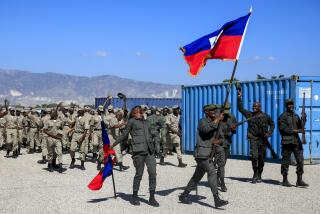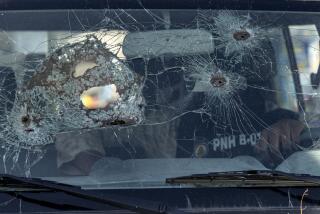CRISIS IN THE CARIBBEAN : U.S. Adopts Cautious Rules of Engagement for Mission : Military: But troops are told to shoot if they feel ‘threatened’ by civilians. Forces will disarm Haitian militiamen.
WASHINGTON — U.S. troops on duty in Haiti have been authorized to fire whenever they feel “threatened” by Haitians with weapons, even if the Haitians do not shoot first, Pentagon officials said Monday.
American forces also will begin disarming Haitian militiamen and civilians found using their weapons against U.S. troops. That effort will be low-key, however, and U.S. soldiers will not conduct house-to-house searches to confiscate guns or other deadly weapons.
At the same time, U.S. troops will not be sent into dangerous slum areas to help quell individual acts of violence, officials said. That job will be left to Haitian police units, with American forces stepping in only if the violence threatens general security.
The cautious rules of engagement, outlined by senior Pentagon officials Monday, appeared designed to avoid some of the difficulties that U.S. forces have encountered in previous engagements in heavily populated areas such as Panama and Somalia.
Critics have charged that American forces killed hundreds of unarmed civilians in the invasion of Panama in December, 1989, because the rules of engagement there were too lax. In 1992 and 1993, the military’s refusal to disarm the population in Somalia was criticized as a crucial oversight.
The ground rules for the Haiti operation were disclosed as American forces completed their first day on the island, apparently without encountering any opposition from the Haitian military or from any civilian groups.
Pentagon officials said that as of late afternoon, only two shots had been fired during the day’s operations in Haiti--both of them by Haitian police officers who were shooting into the air, the traditional means they use to break up crowds that threaten to become unruly.
U.S. military planners said they were making a special effort to enlist the help of Haitian military commander Lt. Gen. Raoul Cedras and existing police units to restore order to the nation. They even had asked some militiamen to return to uniform and to help patrol, the planners said. The theory was that involving the Haitian military would help reduce the risk to American troops.
A senior Pentagon official said the effort would continue as long as the Haitians proved cooperative.
“But if they change the rules, we’ll respond accordingly,” he said.
He said initial indications were that “they are going to cooperate.”
The Pentagon said it expected to have 3,000 to 4,000 U.S. soldiers in Haiti by late Monday evening, with plans to increase the force to as many as 15,000, including a small contingency from Caribbean countries, within a week or two.
The U.S. forces now in Haiti have a four-part mission: to protect U.S. citizens and designated Haitian officials; to help quell armed attacks; to pave the way for civil affairs experts to begin restoring democracy, and to help preserve order.
The bulk of Monday’s U.S. military activity involved unloading troops and equipment from ships, helicopters and C-5 transport planes onto the piers and airfield in Port-au-Prince, the capital.
Pentagon officials said logistics experts will begin today to unload Bradley Fighting Vehicles and other equipment needed to help ensure order and to build up the port facilities. Humanitarian relief efforts are not expected to begin until later this week.
Military operations officers conceded Monday that they were forced to go back to the drawing boards late Sunday night and redesign the entire operation after President Clinton announced that Cedras and his fellow leaders had agreed to step down--but not immediately.
The initial battle plan had assumed that U.S. troops would face one of two contingencies: Either they would have to fight their way onto the island, or the Haitian military would step down and American forces could easily take complete control.
But the eleventh-hour agreement negotiated on Clinton’s behalf by a delegation headed by former President Jimmy Carter provided that while Cedras would not try to block U.S. troops from doing their jobs, he also would remain in power for as long as another month, forcing the Pentagon to change plans quickly.
Over the next few hours, military planners put together a new force package that discarded the initial assault units and picked up with previous plans for a smaller post-invasion force equipped primarily to keep order and pave the way for relief efforts.
It also meant quickly reshuffling the kinds of equipment and weaponry that would be needed for the job.
Military officials said the Pentagon would take the operation a day at a time, watching the effort unfold and adjusting rules and tactics accordingly.
“The intent is, over time, that we will sort these kinds of conditions out,” one official said.
The plan to involve Haitian military and police units is a crucial element in the current U.S. strategy. U.S. military officials met with Cedras on Monday to talk about obtaining that cooperation.
And officials said Washington also hopes to pressure Haitian officials to use their own gun-control laws to reduce the number of weapons in circulation, suggesting that it would help push the Haitians to take more responsibility for their country.
But U.S. military officials warned that the risks still are high and that the situation could sour.
The United States “must be prepared for the unexpected,” Gen. John M. Shalikashvili, chairman of the Joint Chiefs of Staff, said in a briefing.
More to Read
Sign up for Essential California
The most important California stories and recommendations in your inbox every morning.
You may occasionally receive promotional content from the Los Angeles Times.










